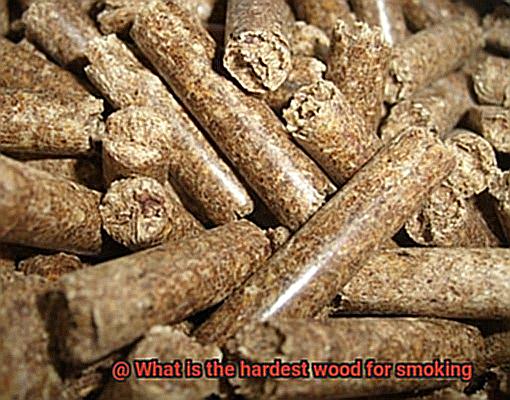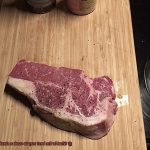Imagine this: it’s a warm summer evening, the sun is setting, and you’re surrounded by your closest friends and family. You’ve got your meat marinated to perfection, but there’s one crucial element missing – the type of wood you’ll use to smoke it. As any grill master worth their salt knows, the type of wood you choose can make or break the flavor of your meat. That’s why we’re here today to answer the burning question: what is the hardest wood for smoking?
Get ready to take a deep dive into the world of smoking wood. We’ll explore all the different types and their unique strengths and weaknesses. Plus, we’ll talk about why using seasoned wood is so important and how density impacts the flavor profile of your meat. By the end of this post, you’ll be able to confidently choose the perfect wood for any grilling occasion.
Whether you’re a seasoned pro or just starting out on your barbecue journey, understanding smoking wood is essential to elevating your skills. So grab a cold drink, kick back, and get ready to become an expert in all things hardwood smoking.
Contents
The Hardest Woods for Smoking
Smoking meat is an art form that requires precision and mastery. One of the key factors that can make or break your smoked meat is the type of wood you use. The hardest woods for smoking are highly sought after due to their slow-burning properties and intense flavor profiles.
Hickory, known for its dense nature, is a top contender among the hardest woods for smoking. It produces a strong and smoky flavor that’s perfect for beef, pork, and poultry. Its slow-burning consistency ensures a steady stream of smoke that infuses your meat with a distinct taste.
Oak, another popular hardwood for smoking, has a milder smoky flavor than hickory but still adds a unique taste to beef and pork. It burns hotter than hickory, so it’s important to keep a close eye on your smoker to avoid over-smoking your meat.
If you’re looking for a bolder and more intense flavor, mesquite is an excellent option. This hard wood burns hot and fast, producing a smoky flavor that’s perfect for beef and game meats. However, be careful not to go overboard with mesquite as its powerful flavor can easily overpower your dish.
For those who prefer a softer hardwood option, applewood is still considered one of the hardest woods for smoking. It burns slowly and produces a sweet, fruity smoke that’s ideal for smoking poultry and pork. Its subtle yet distinct flavor profile makes it a versatile choice for many dishes.
Maple and cherry also make the list of hard woods for smoking. Maple has a mild and sweet flavor that pairs well with poultry and fish, while cherry produces a slightly sweet and fruity taste that complements pork. Experimenting with different types of hardwoods can help you find the perfect flavor profile for your smoked meats.
Hickory: A Popular and Versatile Option
This hardwood is renowned for its slow-burning properties, making it an ideal choice for smoking. Its flavor profile is unique, offering a slightly sweet and nutty taste with a hint of bacon-like smokiness that pairs perfectly with pork and beef. However, hickory wood is also versatile enough to complement the flavors of poultry and fish.
One of the reasons why hickory wood is so popular is its versatility. It pairs well with a wide range of seasonings and rubs, from sweet to spicy. You can even mix it with other woods to create unique flavor combinations that will leave your guests craving more.
To achieve the best results when using hickory wood for smoking, it’s essential to select high-quality wood that has been appropriately seasoned and stored. Soaking the wood chips or chunks in water before use will prevent them from burning too quickly and ensure that you get a consistent and flavorful smoking experience.
Hickory wood is readily available in most regions, making it a convenient choice for those who want to experiment with different types of woods for smoking. Its hardness allows it to burn slowly and hotter than other woods, ensuring a long-lasting smoke and maximum flavor infusion.
Oak: A Slow Burning and Mild Flavor
When it comes to smoking, oak is a top contender for those who want a flavorful yet subtle taste. Its slow-burning properties and mild flavor make it a popular choice among smoking enthusiasts in the United States. Oak wood is often used for smoking meats, fish, and poultry because it produces a mellow smoke flavor that doesn’t overpower the natural taste of the meat.
There are different types of oak wood, but two that are commonly used for smoking are white oak and red oak. White oak is denser and burns slower than red oak, which makes it ideal for smoking. On the other hand, red oak has a stronger flavor and is often used for grilling instead of smoking.
When using oak wood for smoking, it’s crucial to select seasoned wood that has been dry for at least six months. Wet or green wood can produce excessive smoke, resulting in a bitter taste in your meat. To avoid this, use only well-seasoned oak wood chunks or chips.
One exciting thing about oak wood is that you can combine it with other woods such as hickory or cherry to create unique flavor profiles. The possibilities are endless. Additionally, oak wood works well for cold smoking, which involves smoking at low temperatures for several hours. This technique is commonly used for foods such as cheese, nuts, and salmon.
Mesquite: Hot and Fast with a Bold Flavor
Get ready to add some boldness to your cooking with mesquite wood. As an expert on the topic, I can assure you that mesquite is one of the most popular woods for smoking, and for good reason. Its hot and fast burning capabilities make it perfect for grilling or smoking meats that need to cook quickly while still achieving a deep char on the outside. And let’s not forget about its versatile nature that works wonders with both hot and fast cooking or low and slow cooking.
But the real star of the show is mesquite’s intense and bold flavor profile. If you’re a fan of strong smoky flavors in your food, then this is definitely the wood for you. The smokiness adds depth and complexity to your dishes that will leave your taste buds singing with delight. And don’t just limit mesquite wood to meat – it also works wonders with hearty vegetables like potatoes or squash, creating a delicious side dish that complements any main course.
However, be mindful of how much mesquite wood you use as it can be overpowering in large quantities. Start with a small amount and add more as needed to achieve the desired level of smokiness. And when pairing it with other flavors, choose bold and hearty ones that can stand up to its intensity.
Applewood: Sweet and Fruity Smoke
Look no further than applewood, a popular choice among grill masters for its delicious smoke flavor. As an expert in wood-smoking, I can confirm that applewood is the perfect choice for adding a delectable touch of sweetness to your favorite meats and veggies.
Let’s start with the flavor profile. Applewood produces a mild smoke that is ideal for smoking poultry, pork, and fish. Additionally, it adds a subtle sweetness that complements the natural flavors of vegetables, resulting in a mouth-watering and well-rounded taste. The sweet and fruity smoke enhances the overall flavor of the food being smoked, leaving you with a delicious and memorable meal.
But it’s not just about the taste – proper seasoning and dryness are essential when using applewood for smoking. Seasoning involves allowing the wood to dry out for several months before use, which removes excess moisture and ensures a clean and consistent burn. Using dry wood is also crucial to prevent the production of bitter smoke that can ruin your dish.
Now, some may argue that mesquite is the ultimate bold choice for smoking. However, applewood offers a more versatile option that can be used in a wider range of dishes. Overuse of mesquite can overpower more delicate flavors, while applewood adds just the right amount of sweetness without overwhelming other tastes.
The Best Wood for Smoking Depends on Personal Preference
Look no further than the choice of wood you use for smoking. As an expert in the field, I can confidently say that the best wood for smoking depends on personal preference. With so many options available, it’s important to understand that different types of wood can impart different flavors and aromas to smoked food.
For those who prefer a bold and smoky flavor, hickory wood is the way to go. On the other hand, fruitwoods like apple or cherry can add a sweeter and more delicate flavor to your dish. If you’re looking for something earthy and robust, mesquite wood is the way to go. And if you’re after a milder, versatile taste, oak wood is a great choice.
However, personal preference is key when it comes to choosing the right wood for smoking. Experimentation is key to finding your perfect flavor profile- some people may prefer stronger, bolder flavors while others may prefer more subtle hints of smoke.
It’s also worth noting that different meats and foods benefit from different woods. For example, lighter woods like alder or maple are perfect for smoking poultry and fish whereas stronger woods like hickory or mesquite work better for beef and pork.
Here are some tips to guide you through your experimentation:
- Try different woods with the same type of meat or food to see how the flavor changes.
- Don’t be afraid to mix woods for a unique flavor profile.
- Always use dry wood to avoid bitterness or unpleasant flavors.
- Take note of which woods work best for certain dishes and keep them in mind for future smoking endeavors.
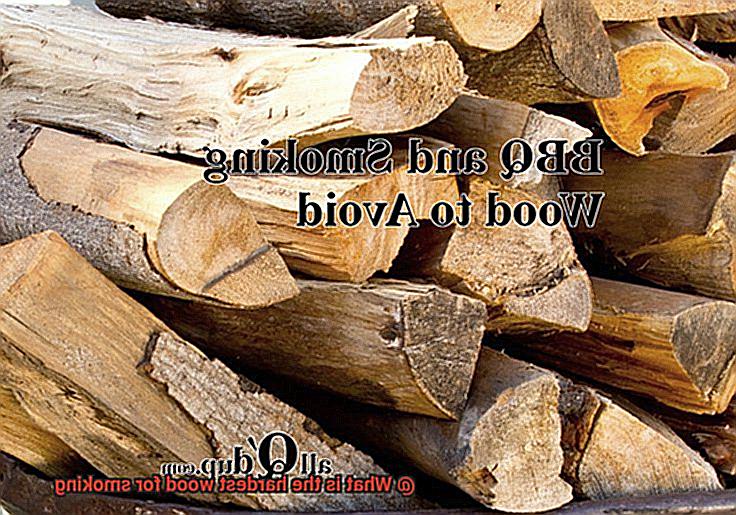
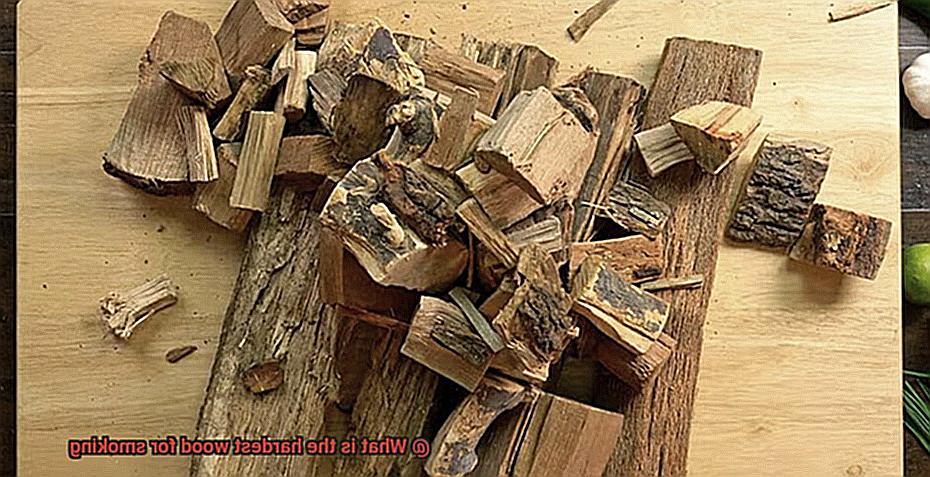
Different Types of Meats to Smoke
Smoking meat is an age-old tradition that has been used to preserve and flavor meat for centuries. But it’s not just about the smoke – the type of wood you use can make a huge difference in the final taste. In this article, we’ll explore the different types of wood that can be used to smoke different types of meat, so you can take your BBQ game to the next level.
Beef
If you want to smoke beef, you need a wood that can stand up to its bold flavor. Hickory, oak, and mesquite are all great options for smoking beef. Hickory adds a slightly sweet and smoky flavor, while oak has a milder flavor that won’t overpower the beef. Mesquite has a strong, earthy flavor that pairs well with beef’s rich taste. Just be careful not to over-smoke your beef – too much mesquite can make it taste bitter.
Pork
Pork is a versatile meat that can handle many different types of woods. Fruitwoods like apple or cherry are often used for smoking pork as they provide a sweet and mild flavor that complements the natural sweetness of pork. Hickory and oak can also be used for smoking pork if you want a stronger flavor. Just be careful not to use too much hickory – it can make your pork taste bitter if over-smoked.
Poultry
Chicken and turkey require a more delicate smoke, so lighter woods like alder or maple are often used. These woods provide a subtle flavor that won’t overpower the mild taste of poultry. Hickory and mesquite can also be used for smoking poultry if you want a stronger flavor, but be careful not to use too much as it can make your poultry taste bitter.
Fish
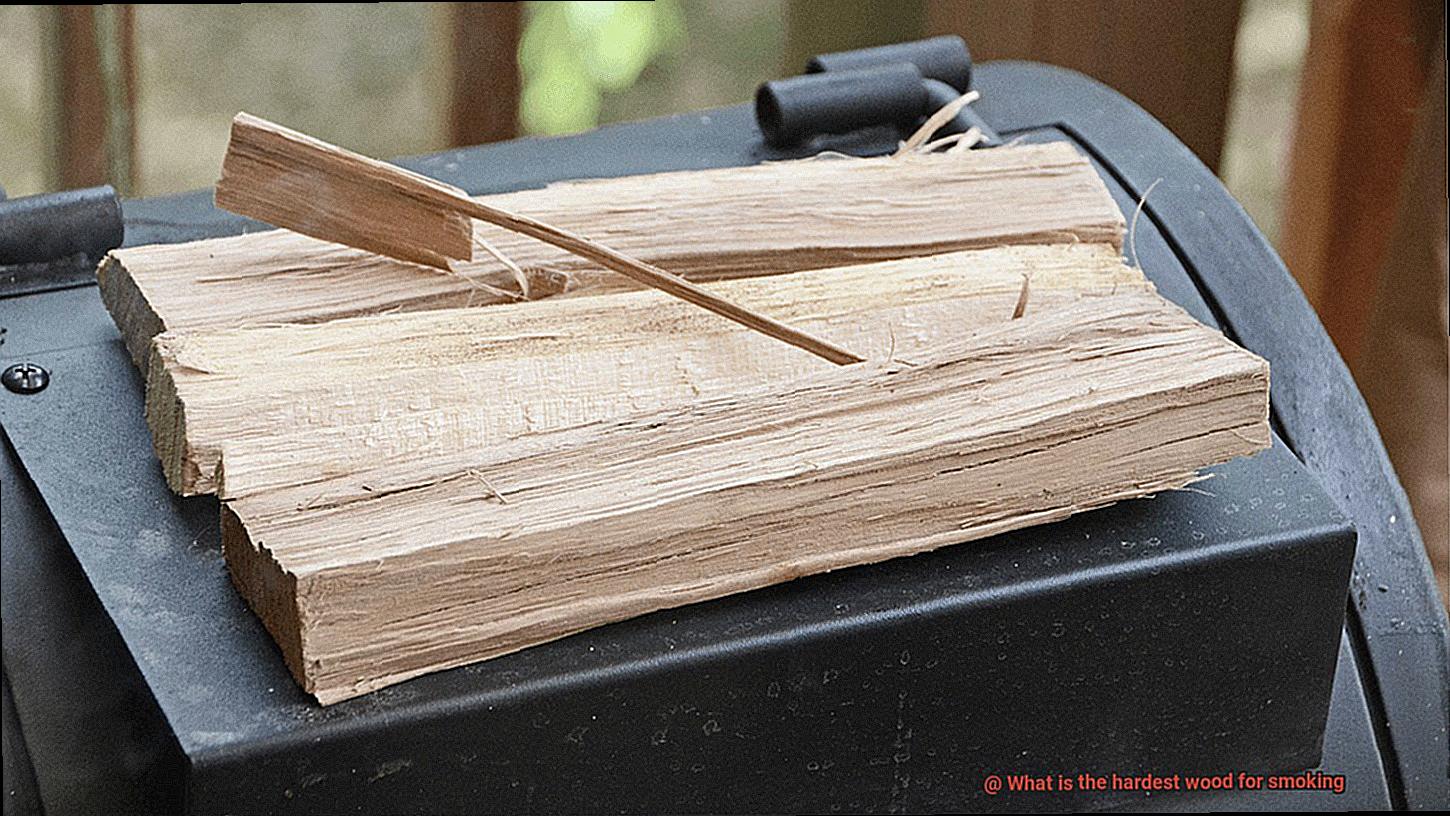
Smoking fish can be tricky because it requires a delicate smoke that won’t overpower the natural flavor of the fish. Cedar plank smoking is a popular method for smoking fish as it imparts a subtle smoky flavor while keeping the fish moist and tender. Fruitwoods like apple or maple wood are also good options for smoking fish, as they provide a mild sweetness that pairs well with the delicate taste of fish.
Tips for Selecting the Right Wood for Smoking
Smoking meat is a time-honored tradition that requires patience, skill, and the right type of wood. But with so many options out there, how can you be sure you’re choosing the right one? Here are some tips for selecting the right wood for smoking that will help you take your culinary skills to the next level.
Consider the Type of Meat
Different types of meat call for different types of wood. For instance, pork and beef pair well with hickory, while applewood is a popular choice for poultry and fish. By selecting the right wood, you can enhance the natural flavors of the meat and create a mouth-watering dish that will leave your guests wanting more.
Know Your Smoke Intensity
The intensity of your smoke flavor depends on the type of wood you use. If you prefer a mild smoke flavor, fruitwoods like cherry or peach are great options. But if you’re after a bold and smoky flavor, mesquite or oak may be more suitable. Knowing your smoke intensity will help you achieve the perfect balance of flavors in your smoked meats.
Avoid Softwoods
Softwoods like pine or cedar may seem like a tempting option, but they should never be used for smoking. These woods contain high levels of resin that can create an unpleasant taste and even be harmful to consume. Stick to hardwoods like oak, hickory, and mesquite for best results.
Experiment
Don’t be afraid to experiment with different types of wood and combinations to find what works best for your taste preferences. You may discover a new favorite wood that brings out unique flavors in your smoked meats. So try mixing things up and see what works best for you.
Use Dry Wood
Dry wood is crucial for achieving the perfect smoke flavor in your meats. Wet or green wood can create too much smoke and give your meat a bitter taste. It’s important to use wood that has been properly seasoned for at least six months before smoking. If you don’t have the time to season your own wood, you can always buy pre-dried wood chips or chunks from your local hardware store or online.
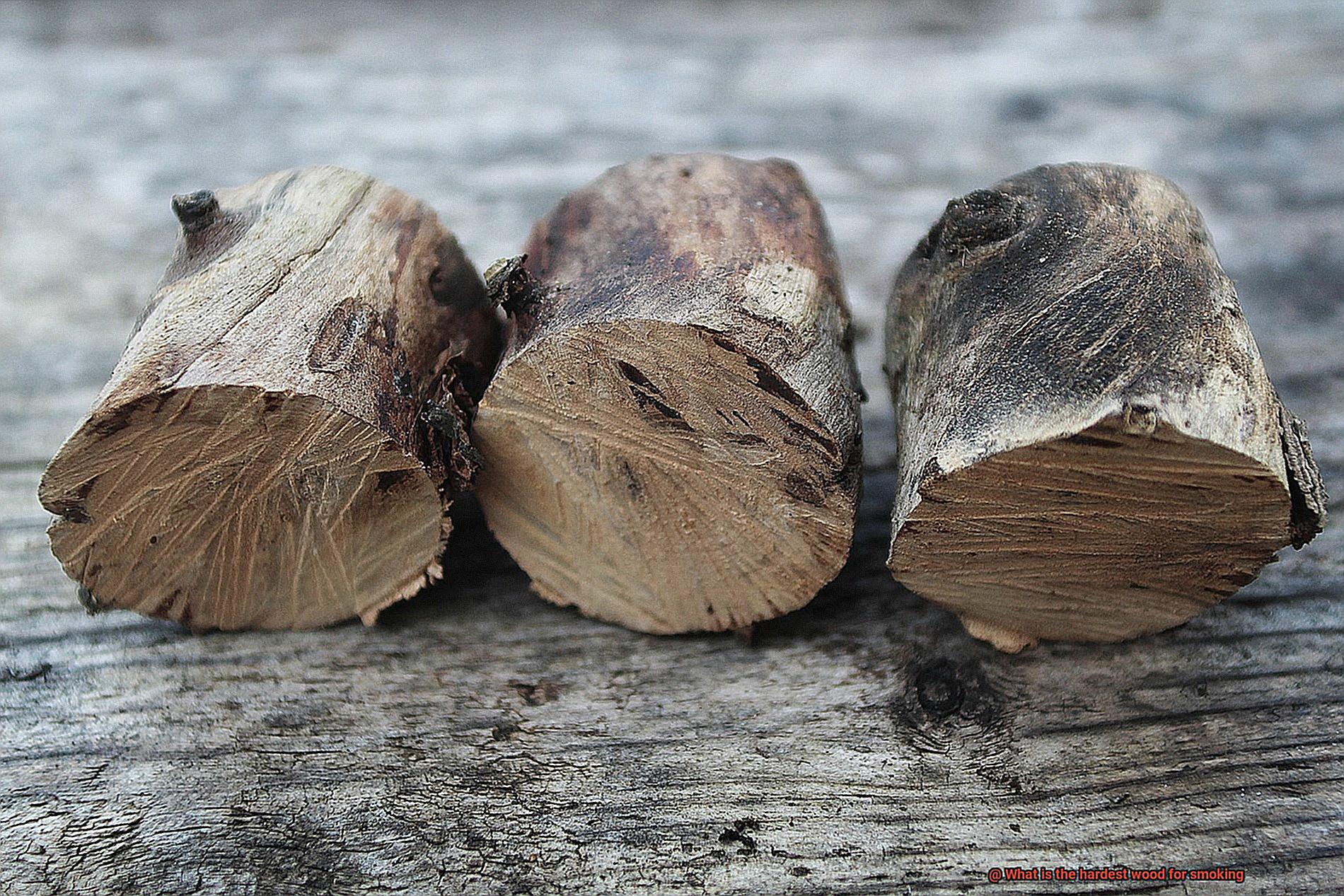
Consider the Size of Your Wood Pieces
The size of your wood pieces can also affect the outcome of your smoked meats. Smaller pieces like wood chips burn faster and are great for shorter smoking sessions, while larger chunks provide a slow and steady burn for longer smoking sessions. Experiment with different sizes and types of wood to find what works best for your particular smoker and meat.
He-Nw5-LMrE” >
Conclusion
In conclusion, selecting the right wood for smoking is an essential aspect of creating mouth-watering and delicious smoked meats. The type of wood you choose can have a significant impact on the flavor profile of your meat, so it’s important to understand the unique strengths and weaknesses of each hardwood.
Hickory, oak, mesquite, applewood, maple, and cherry are all popular options for smoking. Each has its own distinct flavor profile that complements different types of meats and dishes. Hickory is a versatile option that adds a slightly sweet and nutty taste to beef, pork, and poultry. Oak provides a milder smoky flavor that won’t overpower the natural taste of meat. Mesquite offers a bold and intense flavor that pairs well with beef and game meats. Applewood produces a sweet and fruity smoke ideal for smoking poultry and pork.
When selecting wood for smoking, there are several crucial factors to consider. First, think about the type of meat you’ll be cooking – different woods pair better with certain types of protein. Second, consider your smoke intensity preferences – some woods produce stronger smoke than others. Thirdly, avoid softwoods like pine or cedar as they contain high levels of resin which can ruin your meat’s flavor profile.
Experimentation is key when it comes to finding your perfect combination of smoking woods. Don’t be afraid to try out different types or even mix them together to create unique flavor profiles that suit your taste buds. And remember to use dry wood that has been properly seasoned for at least six months before smoking.
Finally, keep in mind the size of your wood pieces – smaller chips burn faster while larger chunks provide a slow and steady burn. With these tips in mind, you’ll be well on your way to elevating your BBQ game by confidently choosing the perfect hardwood for any grilling occasion.

